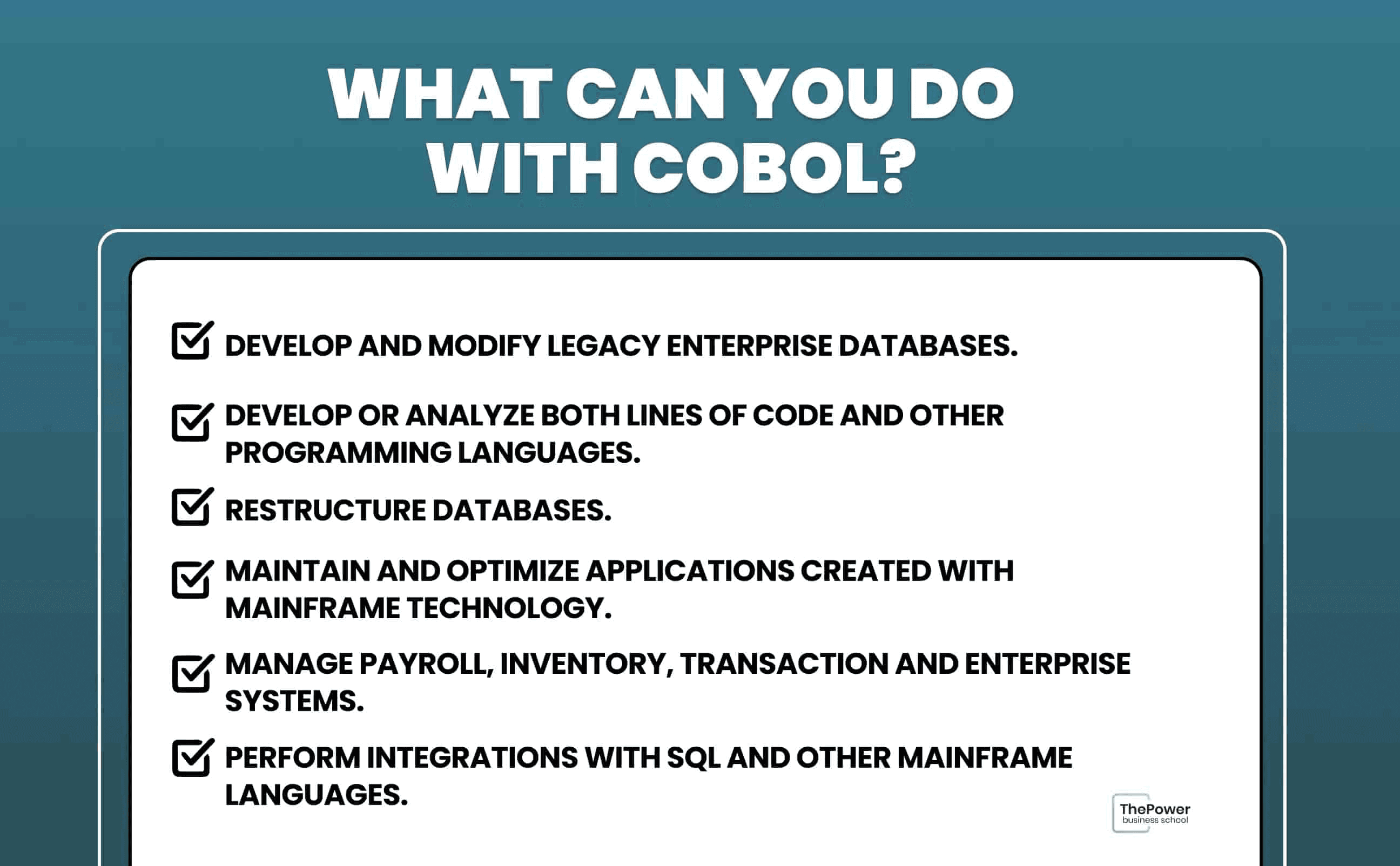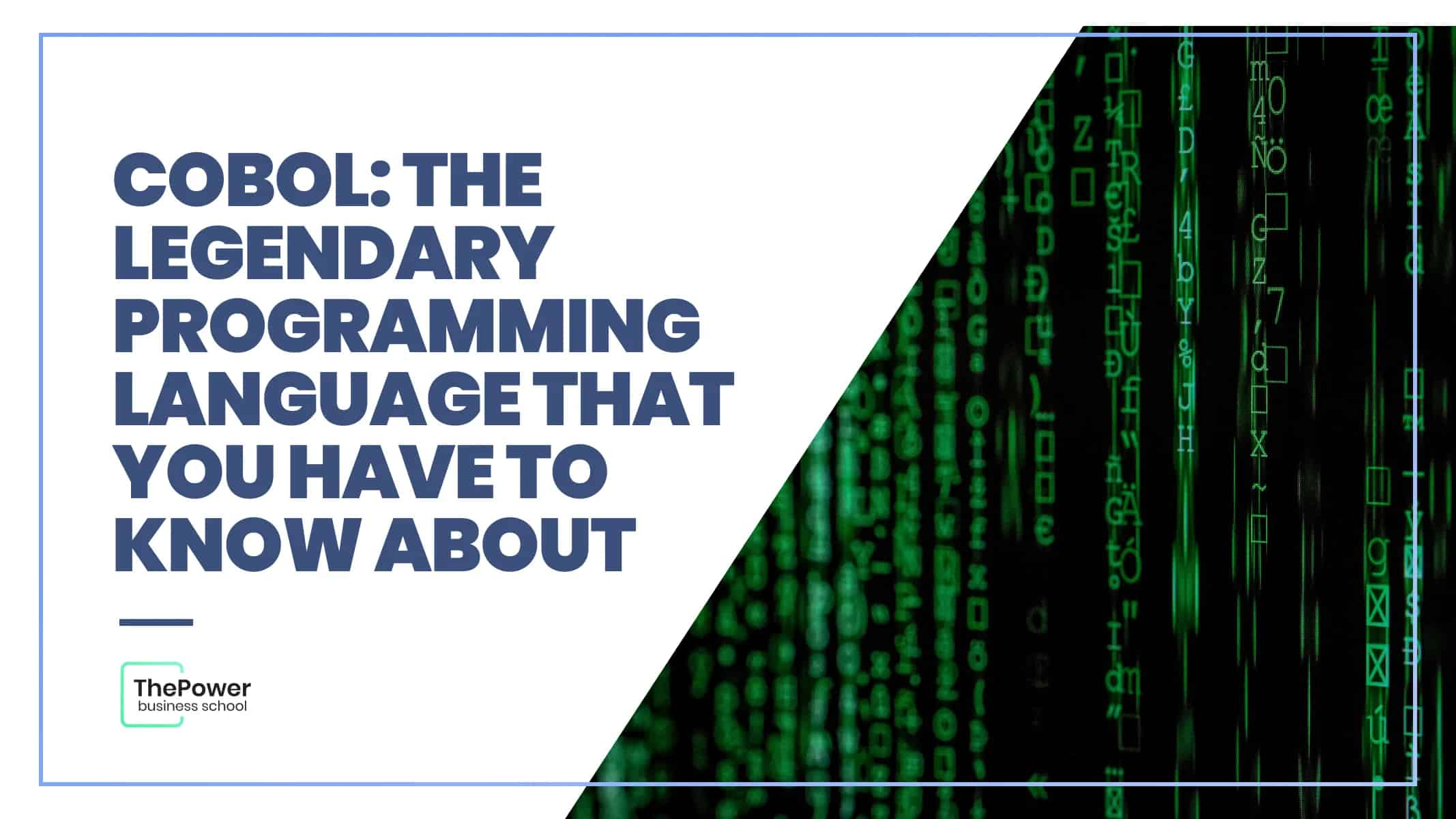COBOL: the legendary programming language that you have to know about

Franco Brutti
By 1959, computers were nothing more than giant, clunky calculators, with primitive and extremely complicated programming languages - all dinosaurs. COBOL was created by Grace Murray Hopper (1906-1992), also known as "the first hacker in history" and the creator of the first compiler in history.
This language emerged in 1959 as a solution for companies to share the same programming language to facilitate business cooperation, in other words, for companies to speak the same language. A language that would revolutionize the business world and would initiate the digital era we live in today.
However, COBOL has seen better days. Languages such as HTML, Java, Python, R, and C have completely taken over the digital world, replacing many of the systems and software created with these languages.
Is COBOL still worth learning, is it worth getting into COBOL these days? In this article, we'll tell you what you need to know about this language, where it is used, and what opportunities it can offer you:
What is COBOL and what is it for?
COBOL (Common Business-Oriented Language) is one of the oldest and most historic programming languages.
It was designed for commercial and business applications and became the standard in the business world in the 60s and 70s.
At that time, when computing was taking its first steps, programming languages began to proliferate. However, there was no single language for business.
This language is entirely based on English to make it easier to read for the common user, not just programmers.
It was designed to handle huge amounts of data on a large scale, especially financial records and transactions, payroll, audits, and inventory records, among other tasks.
At the time, COBOL was a ground-breaker, laying the foundation for the programming languages we use today.
COBOL was one of the pioneering programming languages in business, and it’s the basis for thousands of computer systems still in use today. In fact, most banks and government agencies, among other companies, still work with this system.
Today, COBOL is still part of companies, organizations, agencies, and databases, especially government agencies and banks.
How difficult is COBOL?
In essence, COBOL is very easy to learn.
Currently, COBOL is one of the most English-based languages. This means that you can quickly become familiar with its functions just by speaking the language.
In general, learning COBOL can take you 2 to 3 weeks, depending on your previous experience with other programming languages.
Great, isn't it?
And if you're looking to master its entire Mainframe environment, it can take you about two months - again, depending on your experience as a programmer.
Now, the biggest challenge in learning is the availability of material and mentoring.
Remember that learning a programming language is not only about coding in this language but also about knowing the applications, integrations, frameworks, environments, and platforms where you can run them.
What can you do with COBOL?
COBOL is perfect for designing administration systems and basic transactional systems, especially on older machines and systems.
In short, COBOL will allow you to:
Develop and modify old enterprise databases.
Develop or analyze both lines of code and other programming languages.
Restructure databases.
Maintain and optimize applications created with Mainframe technology.
Manage payroll, inventory, transaction, and enterprise systems.
Integrate with SQL and other Mainframe languages.

5 Features of COBOL: what makes it different from other languages?
1. Standard language
As mentioned, COBOL is the base language for millions of applications and systems still in existence. In fact, it is estimated that COBOL accounts for up to 85% of transactions today.
Also, it can be used on multi-user computers such as the IBM AS/400 system and especially on mainframe computers.
2. Totally focused on business
COBOL emerged as an initiative to reduce the business costs of developing, integrating, and translating different programming languages.
It became the standard language for administrations, companies, and government agencies thanks to its range of functions for data collection and management.
However, it’s purely focused on management and transaction tasks. It’s not applicable to web development or app development.
3. Object-oriented
As of 2002, this is an object-oriented language, which means that it can distinguish between classes and objects for software development.
This makes it simpler and more accurate language for error resolution. It also makes it more versatile when programming.
4. Intuitive syntax
Some developers consider COBOL the closest programming language to English. Even above Python and all modern languages. And that's saying a lot.
5. Metalanguage
COBOL is a metalanguage, or in other words, a language for describing other languages. In computer science, metalanguages are used to describe other languages and to create new programming languages or codes through them.
It is also used to make integrations between two programming languages, combine databases, and analyze the source code of the software.

Who uses COBOL and where is it used?
COBOL is the basis of most of today's financial and administrative systems.
This language is crucial to technology as we know it, and is present in banks and governments as well as in insurance companies, administrations, computer networks, medical databases, and even recruitment systems.
Here are some figures:
95% of ATMs use COBOL (which may give you an idea why many have not replaced it).
As of 2017, COBOL was still part of 43% of banking systems.
More than 80% of banking transactions were done in COBOL.
More than 60% of records and databases in the U.S. healthcare system are COBOL-based.
And as far as companies are concerned, these are some of the best-known names that still use this language on a large scale:
IRS.
Fidelity Investments.
California State University Stanislaus.
USAA.
Fiserv.
JP Morgan Chase.
NetSuite INC.
IBM.
Just to mention a few.
Is it worth learning COBOL?
Of course, but not so fast.
A new programming language is synonymous with more and better opportunities. However, we cannot forget that COBOL is more than 60 years old and does not have the same validity.
Therefore, take into account the following considerations:
The demand for COBOL specialists is low, and most COBOL specialists have decades of experience.
Programmers specializing in this language have already retired or are about to retire.
Many companies that still use COBOL have no plans to invest in their databases, only to keep them running.
Many of those that use it are looking to modernize their applications built with this language.
Other companies decide not to change it for fear of affecting or even destroying their entire system.
The offers for junior-level programmers do not overflow the market.
And now let's look at the bright side.
Many companies are looking for a Mainframe developer versed in COBOL to modernize their systems and databases. There are still thousands of companies eager to join the new digital era and reinvent their systems.
Mainframe developers are still in demand. And in this area, COBOL skills are a huge advantage.
And as long as there are companies upgrading their technologies, there will be demand for Mainframe developers.
This programming niche is quite specific and challenging. And that is the biggest advantage of learning COBOL. However, we recommend learning other programming languages if you are looking to become quite a heavyweight in this sector.
For example:
Java.
HTML.
R.
SQL.
C.
C++.
FORTRAN (predecessor of COBOL).
Algol.
All these languages -except FORTRAN and Algol- are among the must-haves for developers and programmers.
How much does a COBOL programmer earn?
Very well, very well. It’s clear that it is worth learning this language, but what about salaries?
We’ve taken on the task of studying the labor demand for specialists in this language. To do so, we’ve checked some of the most popular job portals, the current demand, and the salary figures.
Spoiler alert: the salaries are excellent.
According to Glassdoor, a COBOL programmer can receive about $84,000 per year. Depending on their experience, they can earn up to $106,000, and the highest paid can average up to $130,000 a year.
According to Salary, a COBOL programmer can earn between $71,000 and $89,000 annually. depending on their education and other digital skills.
As you will see, even though programmers and developers of this language are not the most in demand, they enjoy excellent salary offers.
And how much does a Mainframe developer earn?
Because this is where they can offer more opportunities for COBOL specialists, we’ve also investigated the demand for this position.
According to Zippia, Mainframe developers in the United States can earn about $86,000 per year on average.
Meanwhile, Glassdoor points to about $90,000 per year as the median range for this position. And on the other hand, according to Talen, framework developers can average up to $110,000 per year.
Not to mention that there are always companies willing to pay a bit more when hiring specialists.
What do you say, ready to learn how to use this legendary programming language? If you do, you'll have an uncompetitive job niche at your disposal.
Not to mention, you'll gain solid programming and software development skills.
Plus, COBOL can also be the first step toward more complex languages and functions. Not to mention the offers for Mainframe developers.
If you are up for the challenge, you can make your way in the market and get excellent opportunities.
Looking for something specific?
16 feb 2024
12 dic 2023
1 dic 2023
20 nov 2023
17 nov 2023
12 sept 2023





